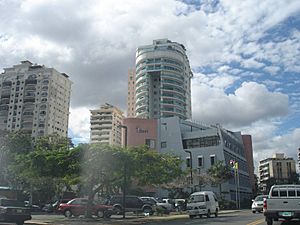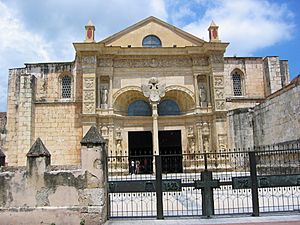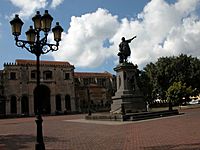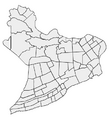Santo Domingo facts for kids
Quick facts for kids
Santo Domingo
|
||
|---|---|---|
|
Municipality
|
||
| Santo Domingo de Guzmán | ||

Santo Domingo partial skyline
|
||
|
||
| Country | Dominican Republic | |
| Province | Distrito Nacional | |
| Municipal Districts | 0 | |
| Founded | 1496 | |
| Municipality since | 1844 | |
| Area | ||
| • Total | 91.26 km2 (35.24 sq mi) | |
| Elevation | 14 m (46 ft) | |
| Population
(2010)
|
||
| • Total | 965,040 | |
| • Density | 10,575/km2 (27,390/sq mi) | |
| • Urban | 965,040 | |
| Time zone | UTC-4 (AST) | |
| • Summer (DST) | UTC-4 (AST) | |
Santo Domingo de Guzmán, or just Santo Domingo, is the capital of the Dominican Republic and is its largest city. It is the oldest European city in the Americas where people have been living since it was founded at the end of the 15th century.
Contents
Geography
The city is at the mouth of the Ozama River, on the Caribbean coast. The city has the Santo Domingo province to the east, north and west. To the south is the Caribbean Sea.
The eastern limit of the city is the Ozama River and the northern limit is the Isabela River, a tributary of the Ozama. The western limit is a long street, Gregorio Luperón Avenue.
The average temperature (25.7 °C) varies little in the city. December and January are the coolest months and July and August are the warmest. Some years, hurricanes affect the city because it is in the Caribbean where hurricanes are common from June to November.
Population
The municipality had, in 2010, a total population of 965,040: 460,903 men and 504,137 women. The urban population was 100% of the total population.
History
The city was first founded on the east side of River Ozama by Bartholomew Columbus, brother of Christopher, with the name of La Nueva Isabela (The New Isabela); La Isabela was a town founded on the northern coast of the island by Christopher Columbus. The name was soon changed to Santo Domingo.
After a hurricane in 1502 destroyed the city, the new governor of the island Nicolás de Ovando built it again but on the west side of the river and with the new name of Santo Domingo.
Santo Domingo was the first capital of the Spanish colonies in the Américas. It became the starting point of most of the Spanish expeditions of exploration and conquest of the other Caribbean islands and the adjacent lands in the continent. There are still many buildings from that time (16th century) and part of the old walls.
In 1930, the city of Santo Domingo was almost completely destroyed by a hurricane called San Zenón. Rafael Trujillo rebuilt the city and named it Ciudad Trujillo after himself. After his assassination in 1961, Ciudad Trujillo became again Santo Domingo. The 1966 constitution named the city Santo Domingo de Guzmán.
In 2001, the Santo Domingo Province was created with much of the area of the old Distrito Nacional ("National District"). With that division, many parts of the old city are now part of the Santo Domingo Province and not of the city of Santo Domingo de Guzmán. But they are still part of the metropolitan area of the city (the Greater Santo Domingo). The people that live in this Greater Santo Domingo are capitaleños (women are capitaleñas), even if they do not live in the National District.
Places of interest
Zona Colonial
The old section of the city is known as Zona Colonial ("Colonial Zone") or Ciudad Colonial ("Colonial City"). The Colonial Zone, bordered by the River Ozama, was declared a World Heritage Site by UNESCO in 1990. Some of the old buildings in this zone are
- Cathedral of Saint Mary, the first cathedral in America.
- Alcázar de Colón ("Diego Columbus' Palace") where Diego Columbus, son of Christopher, lived when he was governor of the Spanish colony.
- Monasterio de San Francisco ("St. Francis Monastery"), an church and place where monks lived (monastery); now is partially destroyed.
- Hospital de San Nicolás de Bari ("St. Nicholas of Bari Hospital"), the first hospital in the Americas; now is partially destroyed.
- Palacio del Gobernador y de la Audiencia ("Palace of the Governor and the Court"); now is a museum, Museo de las Casas Reales ("Museum of the Royal Houses").
- Fortaleza Ozama ("Ozama Fortress"), the oldest fort in America.
Museums
Santo Domingo has several museums, many of them in the Zona Colonial.
- Alcázar de Colón ("Diego Columbus' Palace")
- Naval Museum of the Atarazanas
- Museum of the Casas Reales (colonial period)
- Museum of Duarte
- National Museum of Natural History
- Museum of the Dominican Man
- World of Amber Museum
- Modern Art Gallery
- National Museum of History and Geography
Parks and recreational areas
Santo Domingo has various parks as the National Botanical Garden, the National Zoo and the Mirador Sur Park.
There are also many small squares as the Parque Colón ("Columbus Park"), in the Zonal Colonial and on the northern side of the cathedral; and the Parque Independencia ("Independence Park"), just outside of the old western wall and where the Founding Fathers of the country (Juan Pablo Duarte, Francisco del Rosario Sánchez and Matías Ramón Mella) are buried.
Education
There are eighteen universities in Santo Domingo. Established in 1538, Universidad Autónoma de Santo Domingo (UASD) was the first university founded in the continent; it is also the only public university in the country.
Sports
Santo Domingo is home to the Leones del Escogido and Tigres del Licey baseball clubs of the Dominican Winter League. Estadio Quisqueya is the home stadium for both teams. Centro Olimpico Juan Pablo Duarte is the central sports complex of the city, at the center of the city.
Sister cities
Santo Domingo has sister relationships with many cities worldwide:
Images for kids
-
Tomb that housed the remains of Christopher Columbus until 1795 (at the cathedral).
-
The Ozama Fortress is one of the surviving sections of the Walls of Santo Domingo, which is recognized by UNESCO as being the oldest military construction of European origin in the Americas.
-
Church and Convent of los Dominicos, is the oldest Catholic building in continuous use in the Americas, and also, according to the UNESCO, it was the headquarters of the first university in the Americas.
-
Alcázar de Colón is the only known residence of a member of the Christopher Columbus' family: his first-born son Diego Columbus.
See also
 In Spanish: Santo Domingo para niños
In Spanish: Santo Domingo para niños





































